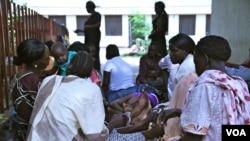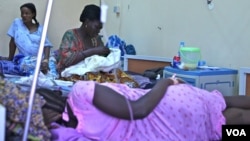JUBA, South Sudan — A year after independence, South Sudan is still battling a lack of staff and resources as it tries to end its distinction of having the highest maternal mortality rate in the world.
In a steaming hot room in South Sudan’s main hospital, women puffing and wailing from labor pains squeeze up next to each other in a maternity ward with just 8 beds.
But more than 90 percent of births in South Sudan happen without the help of a skilled birth attendant, and more than 2,000 women die for every 100,000 live births. This makes South Sudan one of the most dangerous places in the world to have a baby.
With no room left in the maternity unit, 22-year-old Nancy Francisco lies in a nearby ward getting ready to deliver her third baby.
She says that she has decided to come to a hospital because at home, there could be complications such as bleeding. She says she doesn’t know anyone that has died at home, but she has heard about that happening.
The United Nations’ Population Fund (UNFPA) is one of the main agencies trying to combat maternal mortality. But in a country ravaged by more than five decades of civil war until independence from Sudan last year, aid agencies, like the nation, are struggling with the basics.
Gillian Garnett, a UNFPA midwifery specialist, says that she has never seen challenges like those faced in the world’s newest nation - a loss of some 2 million people to the war, countless others fleeing abroad or missing out on basic education.
“One of the major issues here for South Sudan is human resources for health, and in particular midwives. We know that in maternal health and to reduce mortality, access to skilled attendants at birth can reduce maternal mortality as much as 30 percent, and here in South Sudan there’s just a limited number of midwives,” Garnett said.
Garnett says that South Sudan only has eight registered midwives.
Julia Amatoko is one of three that works at Juba’s hospital. She says the three professional midwives only work up until 7 p.m., and that two women have died at night as community midwives and traditional birth attendants cannot cope with serious cases.
“For me, I want all those community midwives to be trained again, and others to be trained again, to increase the quality [of] care [for] the mother,” Amatoko said.
Doctor Mergani Abdalla, a consultant obstetrician and gynecologist at the hospital, says that trying to reduce maternal mortality is hampered by culture and a lack of awareness about maternal health. He says most women wait until the last minute to come to a hospital. He says that even if the drugs and the facilities are there, the hospitals may not have the right people to deal with these cases.
“She is now in a health facility, we can say a secondary health facility. If the personnel is not around, the intervention is delayed also, there will be complications. So, we have the highest maternal mortality in the world, due to bleeding, infection and other indirect causes -- you have malaria, you have HIV, you have anemia, all this,” Merfani said.
Despite building its first blood bank this year, the hospital still relies on a small fridge full of blood donated mainly by relatives for people awaiting surgery.
Breaking down taboos about blood donation will be the only way to fill the bank and stop deaths caused by blood loss, the most common cause of maternal mortality, even in the hospital.
But no one expects a quick fix to a problem in such a vast and neglected country that lacks proper roads needed for women to even reach their nearest health facility.
There is great hope for the first batch of midwives to graduate from school next year. With around 200 new midwives expected to join the ranks, the future for South Sudan’s new mothers looks much brighter.
In a steaming hot room in South Sudan’s main hospital, women puffing and wailing from labor pains squeeze up next to each other in a maternity ward with just 8 beds.
But more than 90 percent of births in South Sudan happen without the help of a skilled birth attendant, and more than 2,000 women die for every 100,000 live births. This makes South Sudan one of the most dangerous places in the world to have a baby.
With no room left in the maternity unit, 22-year-old Nancy Francisco lies in a nearby ward getting ready to deliver her third baby.
She says that she has decided to come to a hospital because at home, there could be complications such as bleeding. She says she doesn’t know anyone that has died at home, but she has heard about that happening.
The United Nations’ Population Fund (UNFPA) is one of the main agencies trying to combat maternal mortality. But in a country ravaged by more than five decades of civil war until independence from Sudan last year, aid agencies, like the nation, are struggling with the basics.
Gillian Garnett, a UNFPA midwifery specialist, says that she has never seen challenges like those faced in the world’s newest nation - a loss of some 2 million people to the war, countless others fleeing abroad or missing out on basic education.
“One of the major issues here for South Sudan is human resources for health, and in particular midwives. We know that in maternal health and to reduce mortality, access to skilled attendants at birth can reduce maternal mortality as much as 30 percent, and here in South Sudan there’s just a limited number of midwives,” Garnett said.
Garnett says that South Sudan only has eight registered midwives.
Julia Amatoko is one of three that works at Juba’s hospital. She says the three professional midwives only work up until 7 p.m., and that two women have died at night as community midwives and traditional birth attendants cannot cope with serious cases.
“For me, I want all those community midwives to be trained again, and others to be trained again, to increase the quality [of] care [for] the mother,” Amatoko said.
Doctor Mergani Abdalla, a consultant obstetrician and gynecologist at the hospital, says that trying to reduce maternal mortality is hampered by culture and a lack of awareness about maternal health. He says most women wait until the last minute to come to a hospital. He says that even if the drugs and the facilities are there, the hospitals may not have the right people to deal with these cases.
“She is now in a health facility, we can say a secondary health facility. If the personnel is not around, the intervention is delayed also, there will be complications. So, we have the highest maternal mortality in the world, due to bleeding, infection and other indirect causes -- you have malaria, you have HIV, you have anemia, all this,” Merfani said.
Despite building its first blood bank this year, the hospital still relies on a small fridge full of blood donated mainly by relatives for people awaiting surgery.
Breaking down taboos about blood donation will be the only way to fill the bank and stop deaths caused by blood loss, the most common cause of maternal mortality, even in the hospital.
But no one expects a quick fix to a problem in such a vast and neglected country that lacks proper roads needed for women to even reach their nearest health facility.
There is great hope for the first batch of midwives to graduate from school next year. With around 200 new midwives expected to join the ranks, the future for South Sudan’s new mothers looks much brighter.







